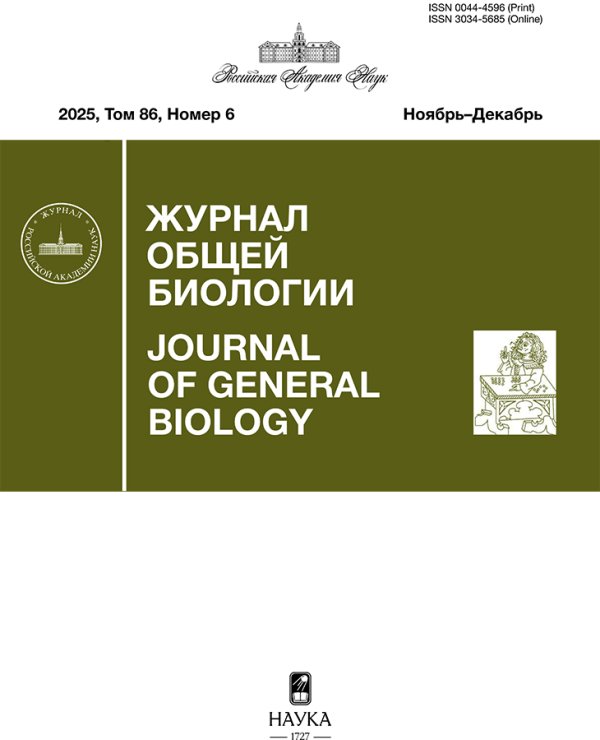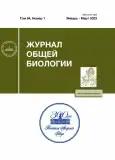Vol 84, No 1 (2023)
Articles
От редколлегии “Журнала общей биологии”
 3
3


Николай Павлович Наумов: ученый, путешественник, учитель
 4-14
4-14


Influence of the French scientific school on the development of bioacoustics in the Soviet Union (60–70s of the last century)
Abstract
The influence of the French scientific school on the development of bioacoustics in the Soviet Union in the 1960–70s is discussed. The main influence on the development of Soviet bioacoustics was provided by the Laboratory of Physiological Acoustics at the National Institute for Agricultural Research of France, created and directed by René-Guy Busnel. Soviet bioacoustics adopted the research experience of France in three main areas: 1) acoustic orientation and signaling of insects; 2) theory and practice of acoustic repellents in agriculture and aviation; 3) sonar systems, acoustic communication and orientation of marine mammals, echolocation. The main research centers in the Soviet Union are listed and the role of Soviet scientists in the development of various areas of bioacoustics in the Soviet Union is considered.
 15-28
15-28


The role of cultural traditions in ecological niche partitioning in cetaceans
Abstract
Ecological niche partitioning is a process that allows organisms to achieve differences in resource use to reduce competition. Niche partitioning is traditionally viewed as a result of modification of genetically inherited traits through the process of adaptive evolution. However, in social animals with developed cognitive abilities, a significant portion of behavioral patterns is transmitted not genetically, but through social learning. Complex sets of behavioral patterns transmitted through social learning are called cultural traditions. The partitioning of ecological niches in cetaceans is most often considered in the context of morphological adaptations: changes in size, skull shape, and the structure of the filtering apparatus. The role of cultural traditions in niche partitioning is still poorly understood, but it is an important and promising area of research, as it provides a novel approach to the ability of animals to change their behavior in order to exploit the environment more efficiently. The main advantage of traditions over genetically inherited behavioral patterns is the ability to change quickly and spread rapidly in a population. Estimating the role of cultural traditions in ecological niche partitioning would highlight the significance of behavior plasticity and social learning in the evolution of animal intelligence. Ecological niche partitioning through the rapidly changing and rapidly spreading behavioral adaptations in the population, allowing to adapt quickly to changes in the environment, could provide a significant evolutionary advantage, which could lead to the development of a relatively high level of intelligence in cetaceans.
 29-36
29-36


Behavioral island syndrome and its ecological drivers in the Mednyi Island Arctic fox
Abstract
Reptiles, birds, and mammals inhabiting oceanic islands tend to change many ecological, behavioral, and genetic characteristics. These changes are referred to as the “island syndrome”. The behavioral components of these changes have been little studied so far. Based on a 40-year study of the biology of the Arctic fox (Vulpes lagopus) on the Mednyi Island, we show that the island Arctic foxes changed many behavioral characteristics compared to mainland foxes. They use smaller home ranges, travel shorter daily distances, and their dispersal distance from the natal territory is much smaller. An increase in the family size of the island Arctic foxes, together with a decrease in litter size, leads to an increase in parental and kin investment and increased cooperation between family members. At the same time, the island foxes, to a large extent, lost their fear of humans. These features are consistent with those found in other island populations. On the other hand, in contrast to other island populations, Mednyi Arctic foxes have increased territoriality, apparently in response to an increased risk of infanticide. Furthermore, Mednyi Arctic foxes expose sex-biased dispersal and maternal inheritance of home range, which are absent in the mainland foxes. The sex-biased dispersal can be considered a mechanism for avoiding inbreeding. Comparison with island fox (Urocyon littoralis) populations in the Channel Islands (Southern California) suggests that these traits have evolved under the influence of specific environmental drivers of the Mednyi Island: patchy and highly predictable resource distribution. The particular resource distribution led to the increased importance of another driver, social landscape, and a new behavioral metatrait of the Mednyi fox – increased conservatism in spatial, reproductive, and foraging behavior.
 37-48
37-48


Evolution of viruses in immunized populations of vertebrates
Abstract
Scientists have described thousands of species of viruses, many of which are pathogens of vertebrates. Given that vertebrates have their highly sophisticated adaptive immune systems capable of memorizing pathogens, interaction with such systems should theoretically be one of the most important factors influencing the evolution of viruses. The review focuses on how acquired immunity (infection-induced and vaccine-induced) affects the most important medical characteristics of viral pathogens – transmissibility, infectivity, and virulence. Both known real examples of the evolution of viruses in immunized populations, as well as theoretical articles and the results of mathematical modeling, are considered. Special attention is paid to the SARS-CoV-2 pandemic. Methodological recommendations are given for creating vaccines and conducting vaccination campaigns in the light of the raised evolutionary issues.
 49-66
49-66


Intraspecific typing and phylogeny of the causative agent of the plague – the microbe Yersinia pestis: Problems and perspectives
Abstract
Two approaches to typing (analysis of intraspecific diversity) and reconstruction of the phylogeny (evolutionary history) of the causative agent of the plague – the microbe Yersinia pestis – molecular genetic (MG) and ecological (adaptationist, on the basis of host adaptation) are considered. It is shown that each of the approaches has its advantages and disadvantages. MG-typing of pathogen strains in the studied foci of the world made it possible to characterize up to 30 subspecies/genovariants of the plague microbe, but the phylogeny of the microbe built on the basis of this diversity contradicts some obvious environmental facts. The ecological scenario of the origin and evolution of the causative agent of the plague has no obvious contradictions and, as an evolutionarily based hypothesis, it should be taken into account in MG reconstructions of the phylogeny of the plague microbe. The prospect of research in this direction is seen in integrating molecular-genetic (statistical) and ecological (adaptationist) approaches.
 67-80
67-80












